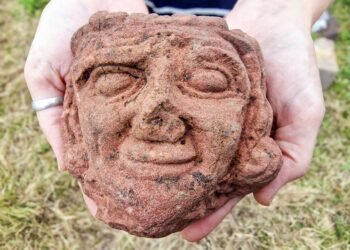Archaeologists and volunteers working at an ancient Roman site in the United Kingdom have unearthed a mysterious purple lump that turned out to be an incredibly rare substance once valued more than gold.

The excavation, managed by Wardell Armstrong, a company specializing in environmental and mining consultancy, took place at a Roman bathhouse located within the grounds of the Carlisle Cricket Club in northern England.
The colorful lump, roughly the size of a ping pong ball, was found in the drain of the 1,700-year-old bathhouse. Further analysis conducted by experts at the British Geological Society and Newcastle University revealed that the lump contained traces of beeswax and bromine, indicating it to be a solid sample of Tyrian purple dye—a pigment highly prized in ancient times. Tyrian purple, also known as imperial purple, was notoriously difficult to produce, requiring thousands of crushed seashells primarily sourced from the Mediterranean, North Africa, and Morocco.
“For millennia, Tyrian Purple was the world’s most expensive and sought-after color,” remarked Frank Giecco, the lead archaeologist on the project. “It’s the only example we know of in Northern Europe—possibly the only example of a solid sample of the pigment in the form of unused paint pigment anywhere in the Roman Empire,” he added.

Tyrian purple was a symbol of wealth and power, reserved for the elite class. Its discovery in Carlisle suggests connections to the imperial court, prompting speculation that even Emperor Septimius Severus might have visited the area.
The excavation has unearthed over 2,800 significant artifacts to date, including coins, gemstones, and monumental stone heads. The site’s location along Hadrian’s Wall underscores its strategic importance during the Roman occupation of Britain from CE 43 to CE 410.
“Following the discovery of the two Roman monumental heads and the other precious items, the project is unearthing some fascinating and globally significant finds. More digs are planned, as well as the opportunity to visit the site and see the groundbreaking work underway,” Cumberland Council councilor Anne Quilter said in a press release.
























